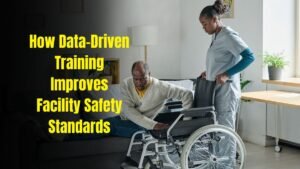Hospital nursing has hit an inflection point. Turnover, vacancies, and burnout have become costly operational risks—and nurse managers sit at the control panel.
In 2024, the average hospital RN turnover was about 16.4%, with each RN exit costing ~$61,110 and a 1% turnover change worth ~$289,000 to the average hospital. These are not soft numbers; they directly shape margins, staffing stability, and patient outcomes.
At the same time, surveys of nursing leaders in January 2025 show an improving sense of belonging but persistent stressors tied to workload and retention—clear signals that leader capability building is paying off yet still needs scale.
The message is simple: investing in nurse leader development—especially for unit managers and supervisors—reduces turnover risk, stabilizes teams, and boosts care quality.
What Great Leadership Training Looks Like In 2025
The AONL Nurse Leader Core Competencies remain the industry framework for the knowledge, skills, and abilities leaders need across settings.
Modern programs map content to these competencies and layer in emotional intelligence, influence without authority, financial acumen, workforce planning, and quality & safety science.
The Non-Negotiables
- People & Culture: Coaching, feedback, psychological safety, and conflict resolution to protect retention and belonging.
- Operations & Finance: Staffing plans, productivity, budgeting, and business cases tied to turnover ROI math.
- Quality & Safety: High-reliability leadership, event review, and closing the loop on nurse-sensitive indicators.
- Data Fluency: Reading dashboards (acuity, HPPD, vacancy, time-to-fill, experience mix) to trigger timely action.
- Well-Being & Burnout Prevention: Skills to detect and address burnout, especially among early-tenure and Gen Z nurses.
- Magnet-Aligned Leadership: Structuring shared governance, professional development, and outcomes documentation that withstand external review.
High-Impact Nurse Leader Training—2025 Essentials
| Component | Why It Matters | 2025 Evidence/Benchmarks | Practical Leader Actions |
|---|---|---|---|
| Turnover & Retention Economics | Links leadership behaviors to hard dollars | $61,110 per RN turnover; $289k per 1% turnover swing | Build a retention ROI dashboard; review monthly with HR/finance |
| Early-Tenure Retention Skills | New hires exit at higher rates without targeted support | Spring 2025 insights: early-tenure exits cluster within first months | Run a first-90-days playbook (buddy, load, schedule, feedback) |
| Emotional Intelligence (EQ) | Predicts job performance and team climate | Programs now include validated EQ assessments | Set a leader EQ baseline; coach on triggers and response habits |
| Workforce Analytics | Faster, data-driven staffing decisions | RN vacancy ~9.6%; time-to-fill ~83 days | Forecast skill-mix; pre-book float/pool; escalate requisitions early |
| Belonging & Culture | Correlates with engagement and retention | Higher belonging reported by nurse leaders in Jan 2025 | Start-of-shift psychological safety checks; celebrate micro-wins |
| Quality & Safety Science | Converts incidents into learning | Magnet-aligned leadership standards emphasize outcomes | Close-the-loop huddles; track leading indicators, not just events |
| Influence Without Authority | Managers lead across disciplines | Featured in reputable leadership programs | Practice stakeholder maps; negotiate shared goals with physicians |
| Career Pathing & Tuition | Keeps high-potential staff in-house | >60% of HC workers would stay for education benefits (2025 survey) | Offer tuition pathways; publish internal ladders and timelines |
Building A 12-Week Leadership Sprint (That Actually Sticks)
Week 1–2: Baseline & Business Case
- Assess against AONL competencies; run an EQ self-assessment.
- Pull unit turnover, vacancy, HPPD, overtime, and premium pay baselines.
- Draft a 1-page ROI target (e.g., cut turnover by 2.6%—the 2025 retention goal range—worth ~$750k+ at scale).
Week 3–4: Culture & Communication
- Micro-lessons on clarity, coaching, and feedback; practice difficult conversations.
- Implement a weekly recognition ritual and after-action reviews on incidents.
Week 5–6: Workforce Planning
- Build acuity-aligned schedules; model skill-mix scenarios.
- Create an early-tenure retention workflow: day-0 buddy, dose-controlled assignments, 30/60/90-day check-ins.
Week 7–8: Financial Fluency
- Link staffing decisions to budget and quality outcomes.
- Use RN turnover cost and time-to-fill to set vacancy thresholds that trigger proactive recruiting.
Week 9–10: Quality & Safety Leadership
- Lead learning huddles (blameless), convert trends to preventive countermeasures, and tie changes to Magnet-style evidence.
Week 11–12: Capstone & Scale
- Present a capstone: “Two behaviors I changed, the metrics that moved, and what’s next.”
- Adopt a peer-coaching cadence (bi-weekly for 90 days) to keep the gains.
Five Training Metrics Every Nurse Manager Should Track Monthly
- Early-Tenure Turnover (0–12 months)—goal: consistent month-over-month decline.
- RN Vacancy & Time-to-Fill—goal: vacancy below 9.6% and time-to-fill under 83 days.
- Belonging/Engagement Pulse—leaders report higher belonging; protect and widen that trend.
- Premium Labor Hours (OT/Agency) Per Patient Day—goal: steady reduction as stability improves.
- Near-Miss Learning Rate—number of proactive improvements implemented per month.
Training Formats That Work In 2025
- Blended Learning: Short virtual sprints plus on-unit application beats lecture-only courses.
- Cohort-Based Programs: Cross-unit cohorts create a peer network that sustains behavior change.
- Applied Projects: Every module ends with “try-this-tomorrow” moves linked to a metric.
- Micro-Coaching: 20-minute real-time coaching after tough conversations or incidents.
- Validated Assessments: EQ and 360s to personalize development; repeat at 6 months.
Special Focus: Gen Z & Early-Career Nurses
Data from 2025 shows Gen Z had the highest turnover in 2024 (~24%) and that 18% of new graduates leave within the first year.
Your leadership training must include generation-savvy coaching, clear growth ladders, and tuition-supported pathways to stem that loss.
What to build into manager training:
- Expectation Contracts: Agree on learning goals, schedule predictability, and feedback cadences.
- Career Map Day: Show how to move from novice to charge/clinical ladder within fixed timelines.
- Skills Dojos: Low-stakes practice for high-stress procedures (paired with debriefs to reduce anxiety).
Aligning With Magnet And Enterprise Strategy
Whether you’re Magnet-designated or on the journey, your training should reinforce shared governance, professional development, and outcomes documentation that Magnet frameworks expect—while avoiding “paper compliance.”
Focus on visible leader behaviors that nurses actually feel: accessibility, transparent decisions, and consistent recognition.
Quick Wins Nurse Leaders Can Implement This Quarter
- Start Every Huddle With A Win: Prime the unit for belonging and psychological safety.
- Retention Rounds: Weekly check-ins with early-tenure nurses; track issues by theme and remove friction quickly.
- Vacancy Heatmap: Post your time-to-fill and escalate requisitions before you cross the risk threshold.
- EQ Micro-Drills: One emotional regulation tool per week (pause, name, reframe) to model calm under pressure.
- Tuition Pathway Flyer: Show staff the education benefits available; retention improves when growth is visible.
Addressing The System Gap: Why Training Still Lags In Some Settings
Even with clear ROI, some systems underinvest in structured leadership development, creating capability gaps that slow reform and frustrate teams.
Recent reporting from the UK highlighted very low per-leader training spend and large numbers of vacant senior roles—a cautionary tale: underfunding leadership pipelines compounds workforce shortages.
Implementation Blueprint For Chief Nursing Officers
- Adopt A Competency Map: Use the AONL framework to define role-based curricula (assistant manager, manager, director).
- Fund A 12-Week Core + 90-Day Sustainment: Tie capacity release to staffing plans.
- Instrument The ROI: Track turnover, vacancy, time-to-fill, premium hours, and engagement monthly; publish a simple leader scorecard.
- Make It Experiential: Mandatory applied projects on each unit; executive sponsors review outcomes.
- Protect Leader Time: Aim for 4–6 hours/month of protected training + coaching.
- Scale Through Peer Coaches: Train high performers to coach cohorts, spreading practices faster.
Leadership training for nurse managers and supervisors is the most reliable lever health systems have to stabilize staffing, protect quality, and improve financial performance in 2025.
Programs mapped to AONL competencies, infused with EQ and coaching, and measured against hard workforce metrics deliver repeatable ROI: lower turnover, faster time-to-fill, higher belonging, and fewer premium labor hours. The playbook is clear. The numbers are current. The mandate is urgent—and the payoff, substantial.
FAQs
How much budget should a hospital allocate to nurse leader training?
A practical starting point is enough to offset a 1–2% turnover reduction on targeted units. Given ~$289k per 1% turnover swing at the average hospital, even modest improvements can justify multi-unit programs.
What’s the fastest way to show impact?
Target the first 90 days for new-to-unit and new-to-practice nurses. Implement a buddy system, right-sized assignments, and scheduled check-ins; report early-tenure turnover monthly to show quick wins.
Which single capability moves the most metrics?
Coaching + EQ, taught with real-play and on-unit coaching, consistently improves belonging, conflict resolution, and retention—especially with Gen Z teams.




